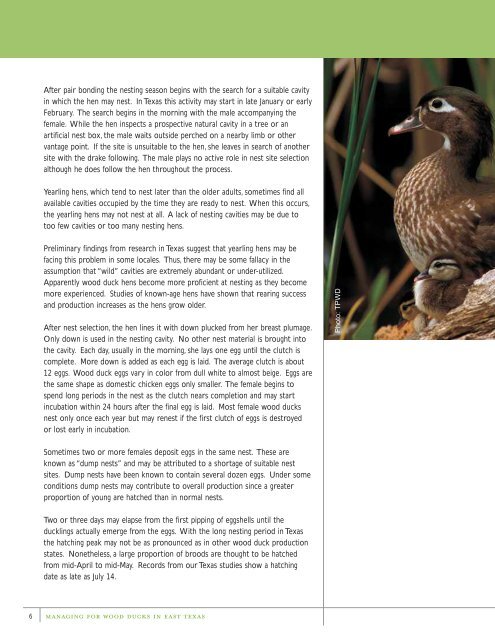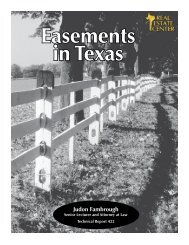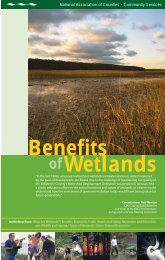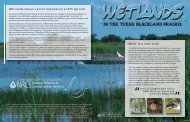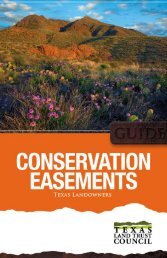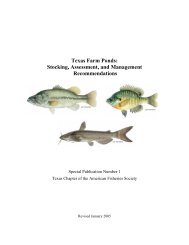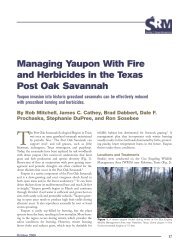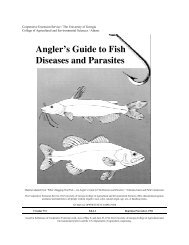Managing for Wood Ducks in East Texas - Trinity Waters
Managing for Wood Ducks in East Texas - Trinity Waters
Managing for Wood Ducks in East Texas - Trinity Waters
Create successful ePaper yourself
Turn your PDF publications into a flip-book with our unique Google optimized e-Paper software.
After pair bond<strong>in</strong>g the nest<strong>in</strong>g season beg<strong>in</strong>s with the search <strong>for</strong> a suitable cavity<br />
<strong>in</strong> which the hen may nest. In <strong>Texas</strong> this activity may start <strong>in</strong> late January or early<br />
February. The search beg<strong>in</strong>s <strong>in</strong> the morn<strong>in</strong>g with the male accompany<strong>in</strong>g the<br />
female. While the hen <strong>in</strong>spects a prospective natural cavity <strong>in</strong> a tree or an<br />
artificial nest box, the male waits outside perched on a nearby limb or other<br />
vantage po<strong>in</strong>t. If the site is unsuitable to the hen, she leaves <strong>in</strong> search of another<br />
site with the drake follow<strong>in</strong>g. The male plays no active role <strong>in</strong> nest site selection<br />
although he does follow the hen throughout the process.<br />
Yearl<strong>in</strong>g hens, which tend to nest later than the older adults, sometimes f<strong>in</strong>d all<br />
available cavities occupied by the time they are ready to nest. When this occurs,<br />
the yearl<strong>in</strong>g hens may not nest at all. A lack of nest<strong>in</strong>g cavities may be due to<br />
too few cavities or too many nest<strong>in</strong>g hens.<br />
Prelim<strong>in</strong>ary f<strong>in</strong>d<strong>in</strong>gs from research <strong>in</strong> <strong>Texas</strong> suggest that yearl<strong>in</strong>g hens may be<br />
fac<strong>in</strong>g this problem <strong>in</strong> some locales. Thus, there may be some fallacy <strong>in</strong> the<br />
assumption that “wild” cavities are extremely abundant or under-utilized.<br />
Apparently wood duck hens become more proficient at nest<strong>in</strong>g as they become<br />
more experienced. Studies of known-age hens have shown that rear<strong>in</strong>g success<br />
and production <strong>in</strong>creases as the hens grow older.<br />
After nest selection, the hen l<strong>in</strong>es it with down plucked from her breast plumage.<br />
Only down is used <strong>in</strong> the nest<strong>in</strong>g cavity. No other nest material is brought <strong>in</strong>to<br />
the cavity. Each day, usually <strong>in</strong> the morn<strong>in</strong>g, she lays one egg until the clutch is<br />
complete. More down is added as each egg is laid. The average clutch is about<br />
12 eggs. <strong>Wood</strong> duck eggs vary <strong>in</strong> color from dull white to almost beige. Eggs are<br />
the same shape as domestic chicken eggs only smaller. The female beg<strong>in</strong>s to<br />
spend long periods <strong>in</strong> the nest as the clutch nears completion and may start<br />
<strong>in</strong>cubation with<strong>in</strong> 24 hours after the f<strong>in</strong>al egg is laid. Most female wood ducks<br />
nest only once each year but may renest if the first clutch of eggs is destroyed<br />
or lost early <strong>in</strong> <strong>in</strong>cubation.<br />
Photo: TPWD<br />
Sometimes two or more females deposit eggs <strong>in</strong> the same nest. These are<br />
known as “dump nests” and may be attributed to a shortage of suitable nest<br />
sites. Dump nests have been known to conta<strong>in</strong> several dozen eggs. Under some<br />
conditions dump nests may contribute to overall production s<strong>in</strong>ce a greater<br />
proportion of young are hatched than <strong>in</strong> normal nests.<br />
Two or three days may elapse from the first pipp<strong>in</strong>g of eggshells until the<br />
duckl<strong>in</strong>gs actually emerge from the eggs. With the long nest<strong>in</strong>g period <strong>in</strong> <strong>Texas</strong><br />
the hatch<strong>in</strong>g peak may not be as pronounced as <strong>in</strong> other wood duck production<br />
states. Nonetheless, a large proportion of broods are thought to be hatched<br />
from mid-April to mid-May. Records from our <strong>Texas</strong> studies show a hatch<strong>in</strong>g<br />
date as late as July 14.<br />
6<br />
MANAGING FOR WOOD DUCKS IN EAST TEXAS


